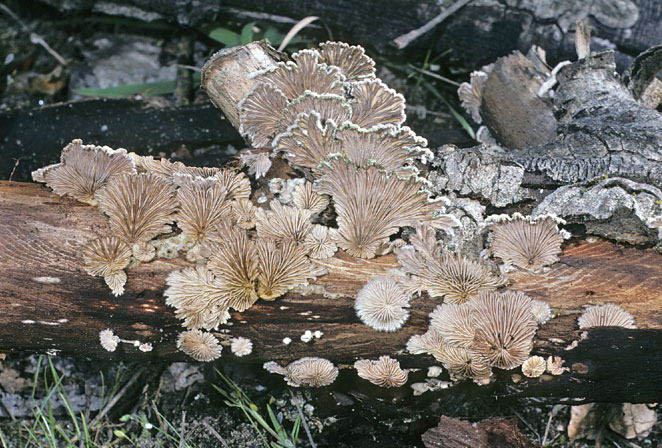
© Kit Scates Barnhart
Danny’s DNA Discoveries – Schizophyllaceae of the PNW
by Danny Miller
|
|
Danny’s DNA Discoveries – Schizophyllaceae of the PNW
|
|
Schizophyllum and Fistulina
abundant common uncommon rare - colour codes match my Pictorial Key and are my opinions and probably reflect my bias of living in W WA. Rare species may be locally common in certain places at certain times. Schizophyllum commune EU - the most common member of this small family, a stemless fan-shaped mushroom usually growing on hardwoods, with a tough, leathery texture and a white fuzzy cap. The critical and unique ID feature is that the gills are each split or grooved lengthwise (the latin literally translates to the "common split gill"). This originally European species is found worldwide, usually with little genetic variation because it can grow practically anywhere - even at least once in the lungs of an immune compromised person, so if so, do not attempt to smell it. This family is in the Agaricales, more closely related to gilled mushrooms than to the polypores of the Polyporales that usually contain the tough species with pores instead of gills. So you can kind of think of Schizophyllum more as a gilled mushroom that evolved to be tough and leathery, instead of a tough polypore that evolved gills (which also has happened). unsequenced Schizophyllum commune © Noah Siegel Fistulina cf americana MA/cf hepatica EU - the famous "beefsteak mushroom" that looks like a raw slab of meat on a tree, that even seems to bleed when squeezed, unique for each "tube" of this 'polypore' being individually separated and not fused together. We need west coast sequences to see if they match the ENA species F. americana or not. EU sequences of F. hepatica vary considerably in ITS and they may have more than one species there. The paper that described F. americana picked one of the concepts of F. hepatica as the real thing, but didn't explain why so there is still confusion about what the west coast species is. unsequenced Fistulina cf americana/cf hepatica © Jonathan Frank (2 images) |